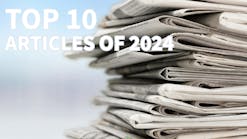One of the books that I keep on my bedside table is a collection of poems called Odes to Common Things. In it, poet Pablo Neruda writes about ordinary objects often taken for granted. In “Ode to my Socks,” the poet outlines the fundamentals of comfort. He analyses a universe of aromatics in “Ode to a Bar of Soap.” And in “Ode to the Spoon,” he unearths the ancient origins of cutlery. In wonderfully unexpected ways, each stanza inspires me to live inquisitively and find magic amid the mundane.
In this issue of Water Efficiency, we observe a variety of essential water technologies from unconventional angles. Ever noticed the poetic simplicity of a level control valve? Or the intricate complexity of a soil moisture sensor? How about the cathedral-like contours of a tank’s interior? Join us as we study these water technologies, looking deeply into their functionality and efficiency-providing potential.
We focus on an integral aspect of asset management in “Trends in Tank Lining” with an up-close look at protective coatings. Corrosion is a persistent threat to all water containing equipment but a durable product layer can ensure that a tank stays clean and leak-proof. By examining the molecular composition of various coating materials, we understand the success of well-engineered corrosion protection products like ceramic-modified epoxies.
In “Exemplary Efficiencies” we look at some of the fundamental, most energy intensive processes in wastewater treatment—from aeration to biosolids processing and pumping—and admire the creative approaches taken by a handful of forward-thinking utilities to optimize energy use. From waste-heat recovery from anaerobic digesters to biogas conversion-to-energy processes and demand management, the organizations we’ve profiled have innovated to effectively reduce costs, create revenues, and stabilize their rates.
Pressure is an essential element of a water system. With close study, pressure monitoring can reveal larger system problems such as leaks or severe ebbs and flows that can weaken pipes and joints, or even crack them. Therefore, an accurate picture of a system’s health is critical. In “Under Pressure” we study the concept of pressure and look at the diverse ways in which today’s advanced pressure monitoring technology makes that possible while helping utilities protect assets and find leaks.
Nearly every utility uses a Supervisory Control and Data Acquisition (SCADA) system to manage the operation of their water system. But some know how to get the most out of it. In “Optimizing Operations” we visit several utilities to learn how they are using their SCADA systems to help with regulatory reporting, streamline their workforces, and enhance their analytics and data management beyond the essential management of their systems.
Irrigation requires careful soil water monitoring. However, we often take for granted the complex function of the sensing equipment that supports our decision-making. In “Soil Water Sensing” Steven R. Evett of the US Department of Agriculture offers us an intimate look at the science behind sensor technology. This in-depth study not only clarifies the differences in sensor technologies, it affords us a glimpse inside these intricate components, and reveals the specific type best suited for certain applications.
In this issue of Water Efficiency, we’ve held essential equipment up to the light and have found new ways to appreciate it. These articles are our odes to common things as well as an invitation to see your system’s mechanics with fresh understanding.
Water and water technologies touch every aspect of human life, often in wonderfully unexpected ways. We celebrate these intersections and their ability to help us see the profound amid the prosaic. There are interesting details everywhere—in the graceful architecture of an impeller or the sleek lining of a pipe. What intriguing elements have you discovered?



